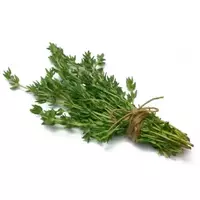Thyme (thyme)

The thyme plant is more common in our latitudes called thyme. The herbal plant thyme or thyme is assigned by scientific classification to taxonomic species from the Yasnotkovy family. Thyme is a stunted shrub that rarely reaches a height of 35 cm. Thyme (thyme) blooms in white or purple small inflorescences. The fruits of the plant resemble boxes, inside which there are nuts having a spherical shape.
Thyme (thyme) refers to important plants from which essential oils and phenolic compounds of thymol and carvacrol are isolated. The content of these biologically active natural substances determines the beneficial properties of thyme (thyme). Chabrets has long been well known to people who have used the beneficial properties of thyme in traditional medicine products and medicines for centuries. There are other names for thyme (thyme) among the people.
In addition to scientific Thýmus or thyme (thyme), the plant is called verest, Bogorodskaya grass, fly-opal, chebark, lemon smell and incense. There are several hundred subspecies of thyme that are distributed throughout Eurasia, Greenland and Africa. Approximately 170 species of thyme plant grow in the Russian Federation and neighboring countries. Thyme is usually found on forest glades, rocky slopes, in the tundra, as well as in the mountains. The type of thyme depends on the place of distribution. For example, Marshall thyme grows exclusively in the steppe regions, and Pallas thyme in the tundra.
Benefits of thyme (thyme)
The chemical composition of thyme (thyme) is rich in the content of essential oils of thymol and carvacrol. In addition to oils, tannins, organic pigments, oleanolic acid, gum and terpenes were found in the plant. The benefits of thyme (thyme) for the human body consist primarily in the chemical composition of the plant. For example, thymol essential oils are used in the production of drugs that help with diseases such as trichocephalosis and helminthiasis.
The active natural ester compound of carvacrol is used in antiseptic agents, since the substance can completely rid the human body of some types of pathogenic bacteria and viruses. Thyme since ancient times has been ranked among medicinal herbs and called "divine grass. " The benefit of thyme (thyme) lies in the excellent disinfecting properties of the plant. Often it is thyme that is part of natural painkillers. Usually, thyme is part of drugs and infusions, as well as thyme is used in therapeutic ointments. The plant helps with radiculitis, rheumatism and joint diseases.
Thyme is considered an excellent antiviral and prophylactic agent. Doctors recommend maintaining the body's immunity, especially in the cold season, when a person is most vulnerable to various colds of viral diseases. Eating thyme (thyme) regularly will help strengthen immunity and prevent colds. In cooking, thyme is usually used dried and as a seasoning for meat, fish and vegetable dishes. Thyme or thyme is part of the famous "herb of Provence" condiment and gives the dish a distinctive taste and aroma.
thyme (thyme) 276 kCal
Energy value of thyme (thyme) (Ratio of proteins, fats, carbohydrates - ju):
Proteins: 9.11 g (~ 36 kCal)
Fats: 7.43g (~ 67kCal)
Carbohydrates: 63.94 g (~ 256 kCal)
Energy ratio (bj | y): 13% | 24% | 93%
 Español
Español Français
Français Português
Português Русский
Русский 简体中文
简体中文 繁體中文
繁體中文 日本語
日本語 한국어
한국어 العربية
العربية Türkçe
Türkçe Қазақ
Қазақ Deutsch
Deutsch Italiano
Italiano Українська
Українська
